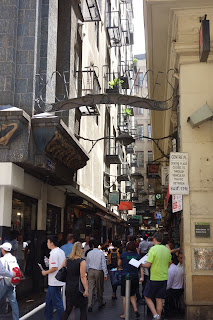Well after my weekend on the houseboat (with so much exercise and physical activity as I'm sure you could tell) I thought it might be a good idea to at least go for a walk, and so that's what I did last Monday - on my last full day with my friends in the Yarra Valley.
Lillydale Lake (and yes that is the correct spelling, despite the fact that the suburb is spelled 'Lilydale' (for all of you who I'm sure noticed)) is an artificial lake and wetlands area in Lilydale (which is the closest urban centre to where my friends live and Melbourne's most eastern suburb). The lake is only one part of the large park area, which covers over 100 hectares. There are about 10 kms of walking trails throughout the whole park, of which I probably walked about 2 or 3 kms. It was a lovely spot.
Tuesday found me travelling back into the city of Melbourne again, and I'm spending this next week back with my friend Jude again. And given that the weather on Wednesday was 34 degrees with brilliant blue skies, I thought it would be good day for a walk - doing walk # 4 which was called "Arcades and Lanes".
Melbourne's many little laneways began life as rear access to properties facing big streets. Many were later roofed as 'arcades' to provide refuge from the weather and crowds and to provide more space for shops. Today, many of these lanes have been reborn and hum to the rhythm of daily city life, and it was along some of them that today's walk took me.
Degraves Street is a mecca for Melbourne's cafe society, and at the end of Degraves Street is the Majorca Building. Built in the heyday of the 1920s the building has both Spanish and Moorish influences.
Centre Place is a breeding ground for cafes, some of them so small you can barely turn around after buying your coffee.
The Block Arcade was built in the early 1890s and it was where 19th century Melbournians liked to promenade or 'do the block'. Today it is still a hive of activity, with interesting shops and beautiful mosaic floors.
Mog and Magog, two legendary giants of the ancient Britons, stand guard at one end of the Royal Arcade. Gog and Magog have been striking the time on Gaunt's clock since 1842 and the Royal Arcade came into existence in 1869.
The Public Purse statue was the winner of a competition in 1994 to design unique and distinctive forms of street seating. It is located on Bourke Street - and a section of this very busy street in downtown Melbourne is closed to traffic, making it the pedestrian only Bourke Street Mall.
The Underground Public Toilets are historic - built in the early 1900s and they are now classified by the National Trust.
At one end of Niagara Lane you can find a row of historic warehouses built in the 1880s. The picturesque barrel hoists are still there and are still functional.
Hardware Lane is another laneway that epitomises Melbourne's laneway renaissance. With cobbled stones underfoot and cafe umbrellas overhead, this is another great place to meet friends and have a coffee (or red wine).
Manchester Unity Arcade was my last stop on the tour today. The arcade is attached to the Manchester Unity building, a neo gothic skyscraper built in 1932. The building contains the first two escalators ever in Melbourne - as well as its original elevator.
And that brought me to the end of 'Arcades and Lanes'.










The public purse is quite unique, and I love all the little laneways.
ReplyDelete